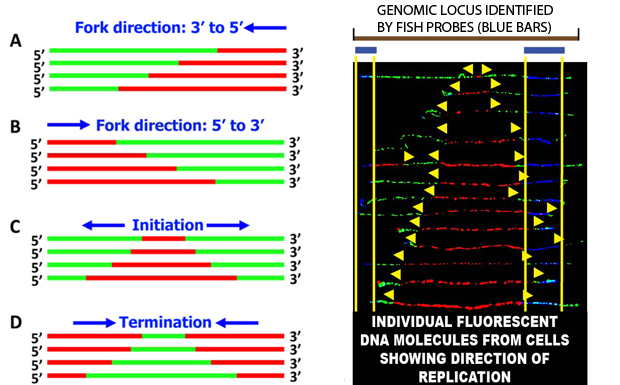|
Professor, Department of Cell Biology
Chanin Bldg., Room 416
718.430.2097
carl.schildkraut@einsteinmed.org
Home Page
The Centromere and alpha satellite DNA and the tau protein
Genomic Instability
Recent Publications
Biosketch
Lab Members
Collaborators
|
|
Research
We are studying the reprogramming of DNA replication using two approaches. We use a single molecule approach we termed SMARD to observe the dynamics of replication across the entire length of long individual DNA molecules. SMARD relies on sequential labeling of replicating DNA with two halogenated nucleoside analogs in exponentially growing cells. The DNA molecules that incorporated these analogs during replication are stained with nucleoside-specific antibodies that emit different colors under fluorescence microscopy. This powerful methodology provides information-rich profiles of replication events including initiation, direction and rate of fork progression, and termination. For details about SMARD methodology click here .
|

|
Single molecule analysis of replicated DNA (SMARD). The transition from red to green in a fully replicated DNA molecule indicates the direction of the replication fork (A, B). A red region surrounded by green indicates a replication initiation site (C) and a green region surrounded by red indicates a replication termination site (D). Distinct patterns of replication can be observed if many molecules are aligned according to their physical map. The representative SMARD result shown in D shows all replication forks proceeding unidirectionally across a genomic region (blue lines denote Biotin-labeled DNA probes to identify DNA molecules of interest).
We also use microarrays and massively parallel sequencing based high-throughput methods to measure global replication timing at high resolution. We analyze how DNA replication affects the reprogramming of somatic cells to iPS cells and early steps in human and mouse embryonic development.
The DNA replication program in embryonic stem cells
Mammalian cells have distinct programs for DNA replication which are implicated in many cellular functions including genome reprogramming, epigenetic modifications, gene expression and development. During differentiation, DNA replication for many gene loci undergoes reprogramming. The characteristics of reprogramming, however, have just begun to be delineated in hES cells. Using SMARD, we are characterizing the replication programs for key developmental regulatory gene loci in human ES cells, iPS cells and hES cell-derived differentiated cells. We are analyzing the role of the replication programs in iPS cell reprogramming, hES cell differentiation and development, as well as maintenance of the pluripotent state.
High throughput analysis of replication timing as an epigenetic characteristic to access the functionality of human ES cells and iPS cells
A key problem in human iPS cell technology is the characterization of the pluripotent state. While mouse iPS cells can be readily tested for their ability to contribute to the developing mouse embryo in vivo, such assays cannot be used for hiPS cells. Therefore it is critical for the field to identify conclusive markers of the pluripotent state that distinguish partially from fully reprogrammed hiPS cells. Such markers would allow the prospective identification of hiPS cell clones most suitable for subsequent regenerative medicine or disease modeling and enable direct comparisons of human iPS and ES cells.
We are using replication timing as an epigenetic characteristic to evaluate the functionality and pluripotent state of hiPS cells. We are applying a novel high throughput approach (TimEx ) that has been devised by Dr. Eric Bouhassira and us to determine genome-wide replication timing in iPS cells to characterize these cells. We are comparing different iPS cell lines to establish whether the differences in the ability of these cell lines to differentiate along specific developmental pathways is accounted for in part by variations in replication timing for some of the gene loci involved in the pathway. These studies will provide a novel assay for determining the extent of reprogramming in hiPS cells.
Genetic and epigenetic regulation of developmentally regulated origins in mammalian cells
We have previously identified developmentally regulated replication origins in the mouse genome which provide an excellent system to examine the mechanism behind origin activation during development. We have established a powerful in vivo system which permits us to introduce genetic and epigenetic changes into a specific site in mouse ES cells in a systematic manner. Using this system we have introduced cis-regulatory elements, activated local gene transcription and increased levels of several key histone modification marks associated with active chromatin. We are analyzing the role of these genetic and epigenetic regulators in origin activation in mammalian cells.
Replication of telomeres
Telomeres are protective structures on the ends of chromosomes whose primary function is to maintain the integrity of the genome. The structure of telomeres is dynamic in nature. Telomeres shorten during replication, which eventually leads to the inability of cells to divide, a state known as cellular senescence. Continuously dividing cells, such as ES and cancer cells, generally overcome this problem through the action of telomerase, which restores lost telomeric DNA. We are investigating the relationship between telomere structure-function and telomere replication. Through comparative study of telomere replication in continuously dividing cells and somatic cells, we will establish whether telomere replication in ES cells and cancer cells is characterized by a unique program In addition we have also been exploring the importance of telomere-specific shelterin proteins on telomere replication programs.
|
|